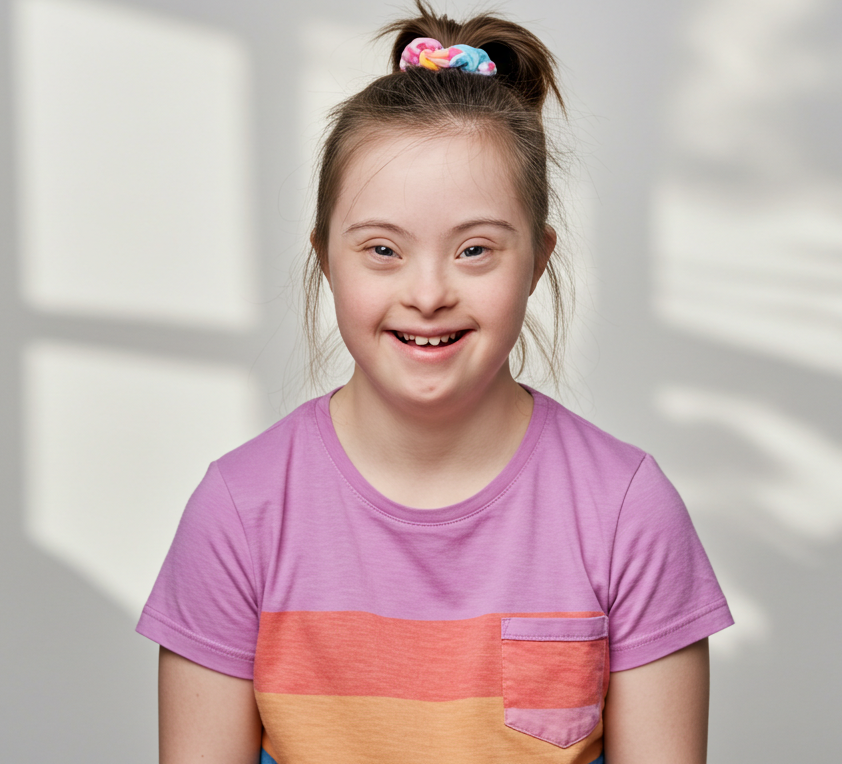Down Syndrome Treatment: Medical, Therapeutic, and Nutritional Options for Supporting Children with Trisomy 21

For families facing a Down syndrome diagnosis, understanding the full range of Down syndrome treatment options is essential for improving quality of life, supporting healthy development, and maximizing a child's potential. While there is currently no known cure for Down syndrome—because it stems from a genetic condition involving an extra copy of chromosome 21—modern treatment approaches aim to manage symptoms, address medical complications, and support developmental growth.
With advances in medicine, therapy, and even nutrition, children with Down syndrome today have more opportunities than ever to thrive. This page will explore the most effective and evidence-based treatments for Down syndrome, including traditional medical care, behavioral and developmental therapy, and emerging nutritional interventions.
Understanding the Basis of Down Syndrome Treatment
Down syndrome (DS), also called Trisomy 21, occurs when a person has three copies of chromosome 21 instead of the usual two. This extra genetic material affects the body’s development and causes a variety of cognitive, physical, and medical symptoms. While the genetic anomaly cannot be reversed, treatment strategies can target the symptoms caused by the chromosomal imbalance—improving learning, behavior, health, and overall function.
A comprehensive treatment plan should be tailored to each individual and include a combination of medical monitoring, therapy services, educational interventions, and supportive care from infancy through adulthood.
Medical Management in Down Syndrome Treatment
Many children with Down syndrome are born with health complications or develop them over time. Early detection and ongoing medical care are critical in reducing risk and improving life expectancy. Some of the most common medical conditions that require treatment include:
- Congenital Heart Defects – Nearly 50% of babies with Down syndrome are born with heart problems. Many require surgery early in life.
- Thyroid Disorders – Hypothyroidism is common and can be treated with daily hormone replacement.
- Hearing and Vision Problems – Regular screening is necessary. Hearing aids or corrective lenses may be needed.
- Seizure Disorders – Some children may require anti-seizure medications if epilepsy develops.
- Sleep Apnea – Obstructive sleep apnea is common due to low muscle tone and physical differences in airway anatomy.
- Frequent Infections – A weakened immune system means children with DS are more prone to respiratory infections and other illnesses.
Doctors may also prescribe medications for co-occurring mental health disorders, including anxiety or ADHD, especially in older children and adolescents.
Routine health checkups and monitoring for common risks are essential parts of Down syndrome treatment to ensure early intervention and continued wellness.
Developmental and Behavioral Therapies for Down Syndrome
Because cognitive delays are a hallmark of Down syndrome, most children benefit from early intervention and specialized therapy programs. These support the child’s ability to learn, communicate, and interact with others effectively.
1. Speech and Language Therapy
Children with Down syndrome often have delayed speech development and may struggle with articulation. A speech-language pathologist can help improve:
- Vocabulary and expressive language
- Understanding of instructions
- Social communication skills
Alternative communication systems, such as sign language, communication cards or even an augmentative communication device, are often used in early years to support language development.
2. Occupational Therapy
Occupational therapy helps children develop the skills they need for daily living. This includes:
- Fine motor skills (grasping, writing, using utensils)
- Self-care skills (dressing, bathing)
- Sensory integration (managing sensory sensitivities)
Low muscle tone (hypotonia) and delayed motor milestones are common Down syndrome characteristics.
3. Physical Therapy
Physical therapy supports:
- Crawling and walking
- Balance and coordination
- Posture and joint strength
4. Behavioral Therapy and Support
Behavioral challenges such as impulsiveness, short attention span, and emotional regulation difficulties are often addressed through:
- Positive behavior supports
- Functional behavior assessments
- Visual schedules or token reward systems
- Parent coaching and support
Children who exhibit autism-like behaviors or have a dual diagnosis of autism and Down syndrome may also require Applied Behavior Analysis (ABA) therapy.
Support and Intervention Strategies
Children with Down syndrome benefit greatly from early, consistent, and personalized support. While medical treatment addresses many of the physical and health-related symptoms, long-term quality of life is often most influenced by educational and developmental support. Let’s explore how these strategies—especially those related to learning—can help children with Down syndrome thrive.
Expanded Educational Support:
Education plays a foundational role in the development of a child with Down syndrome. A tailored approach—beginning in early childhood and continuing into adulthood—can foster both academic achievement and social-emotional growth.

1. Early Childhood Intervention Programs:
From infancy to age three, early intervention services help children build essential skills. These programs often include in-home visits by educators and therapists, who work with parents to support motor, language, and cognitive development. Early access to learning tools like sign language or visual aids can significantly improve later communication and school readiness.
2. Inclusive Classrooms:
Many children with Down syndrome benefit from integrated learning environments where they can interact with typically developing peers. Research shows that inclusive classrooms encourage socialization, model age-appropriate behavior, and boost self-esteem. In these settings, children with Down syndrome often receive modified instruction and individual accommodations without being isolated.
3. Individualized Education Plans (IEPs):
In public school systems, children with Down syndrome are eligible for an IEP—a customized education plan that addresses their specific strengths, weaknesses, and learning goals. IEPs are developed collaboratively by educators, parents, therapists, and special education professionals, and may include adaptations such as:
- Extended time for assignments or tests
- Use of assistive technology (e.g., tablets, speech-to-text tools)
- Visual learning supports like charts and picture schedules
- Modified curriculum with a focus on practical life skills and functional academics
4. Special Education Professionals:
Supportive staff such as speech-language pathologists, special education teachers, occupational therapists, and behavioral therapists work together to help students build communication, motor, and social skills alongside academics. Regular collaboration between general education and special education teachers ensures continuity and consistency.
5. Functional Skill Training:
For some students, academic progress may be best paired with instruction focused on daily living, vocational, and social skills. These skills—including cooking, using public transportation, or handling money—help prepare children for increased independence as teens and adults. Functional curriculum may be taught in both classroom and community settings.
6. Transition Planning:
As students approach middle and high school, transition planning becomes a key part of their education. This includes setting goals for employment, post-secondary education, and independent or supported living. Transition services often involve partnerships with vocational programs, job coaching, or training centers.
7. Parental Involvement and Advocacy:
Parents are essential partners in their child's educational journey. Attending IEP meetings, collaborating with educators, and advocating for appropriate resources can ensure that the child receives consistent and effective support. Training programs for parents can also empower them to support learning at home and understand their child’s rights under the law (such as IDEA in the U.S.).
8. Social-Emotional Learning (SEL):
Children with Down syndrome can benefit from targeted support in understanding emotions, managing frustration, and developing empathy and friendship skills. Many schools incorporate SEL curriculums that teach students how to express their feelings, resolve conflict, and build positive relationships—critical components of success in both school and life. The following animated videos on Brave Kid Adventures use video modeling to help children manage their emotions and learn coping skills.
Nutritional Approaches in Down Syndrome Treatment
In recent years, there has been increasing attention on the role of nutrition in managing and potentially reducing the symptoms of Down syndrome. Some researchers and practitioners believe that early nutritional intervention may support brain function, reduce metabolic imbalances, and even prevent the onset of certain symptoms.
Children with Down syndrome are often at risk for:
- Obesity
- Gastrointestinal issues
- Vitamin and mineral deficiencies
- Poor muscle tone related to low metabolic activity
A targeted nutritional protocol may include:
- Folic acid, B6, and B12 – To support methylation and cognitive function
- Zinc and selenium – For immune health
- Antioxidants – To counteract oxidative stress
- Omega-3 fatty acids – To support brain development
One emerging protocol known as The Warner Protocol for Trisomy 21 suggests that early nutritional therapy—started in infancy—may reduce or even prevent the development of some common Down syndrome symptoms. While still considered an alternative or complementary approach, many families report positive outcomes when combining nutrition with traditional therapies.
Is There a Cure for Down Syndrome?
Currently, there is no cure for Down syndrome, as the condition is rooted in genetics. However, that does not mean a child’s potential is limited. With a holistic and proactive treatment plan, many children with Down syndrome grow into happy, healthy, and independent adults.
The key is to begin treatment early, monitor progress, and adapt the support as the child develops. This includes combining medical care, therapies, nutrition, and educational accommodations, along with strong family and community support.
Conclusion
Down syndrome treatment is multi-faceted and ever-evolving. From addressing medical needs and developmental delays to exploring cutting-edge nutritional therapies, there are many ways to help children with Down syndrome thrive. Early intervention is essential, and personalized care—backed by love, patience, and evidence-based strategies—can lead to tremendous growth and improved quality of life.
Whether you’re a new parent, caregiver, or educator, staying informed about treatment options empowers you to make the best choices for your child or loved one living with Down syndrome.
References
1. Healthy.net. Down’s syndrome: Treating the untreatable. www.healthy.net. 3/9/11.
If you haven't already, be sure to check out my ebooks, now on Amazon!

